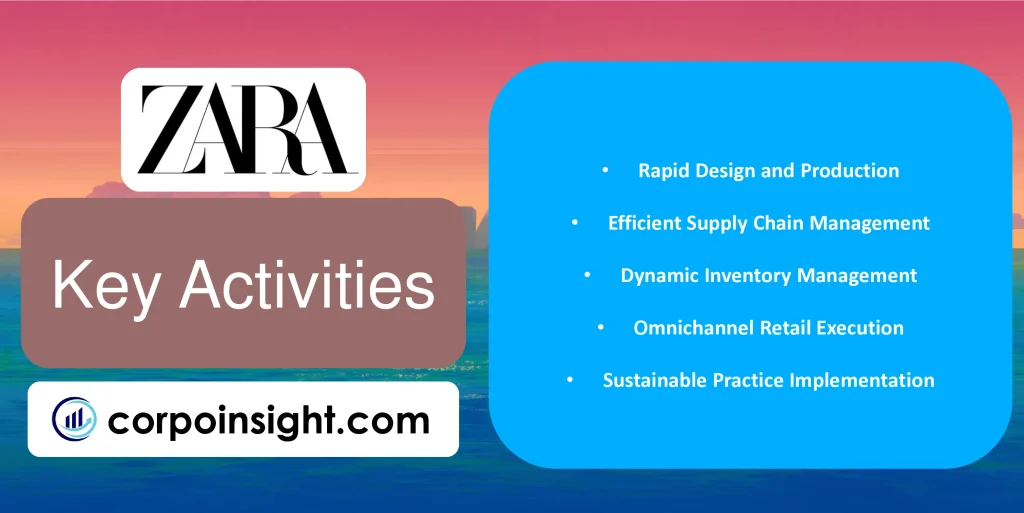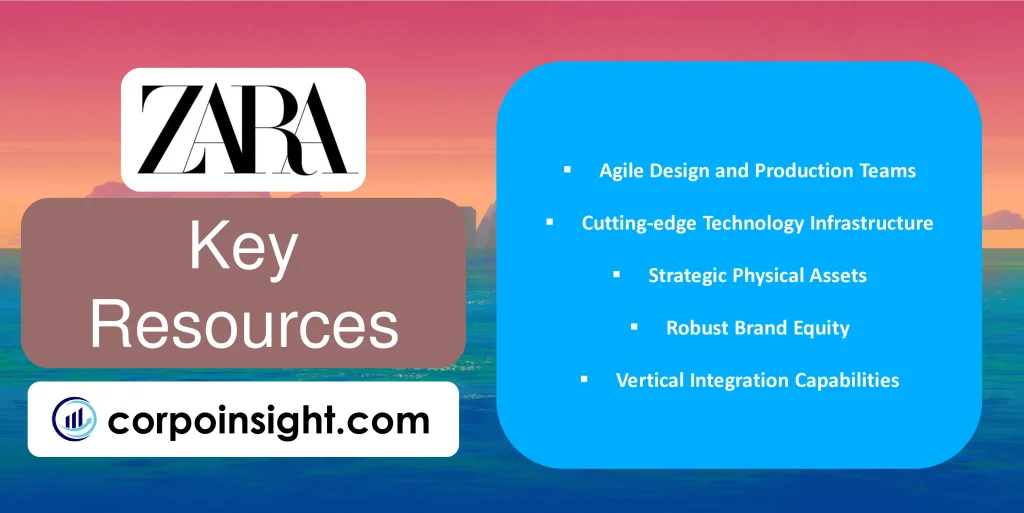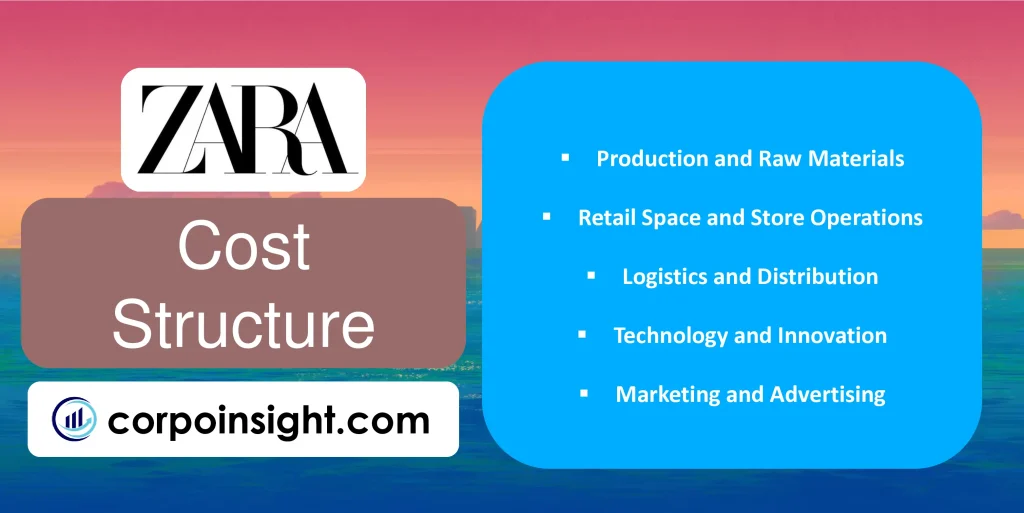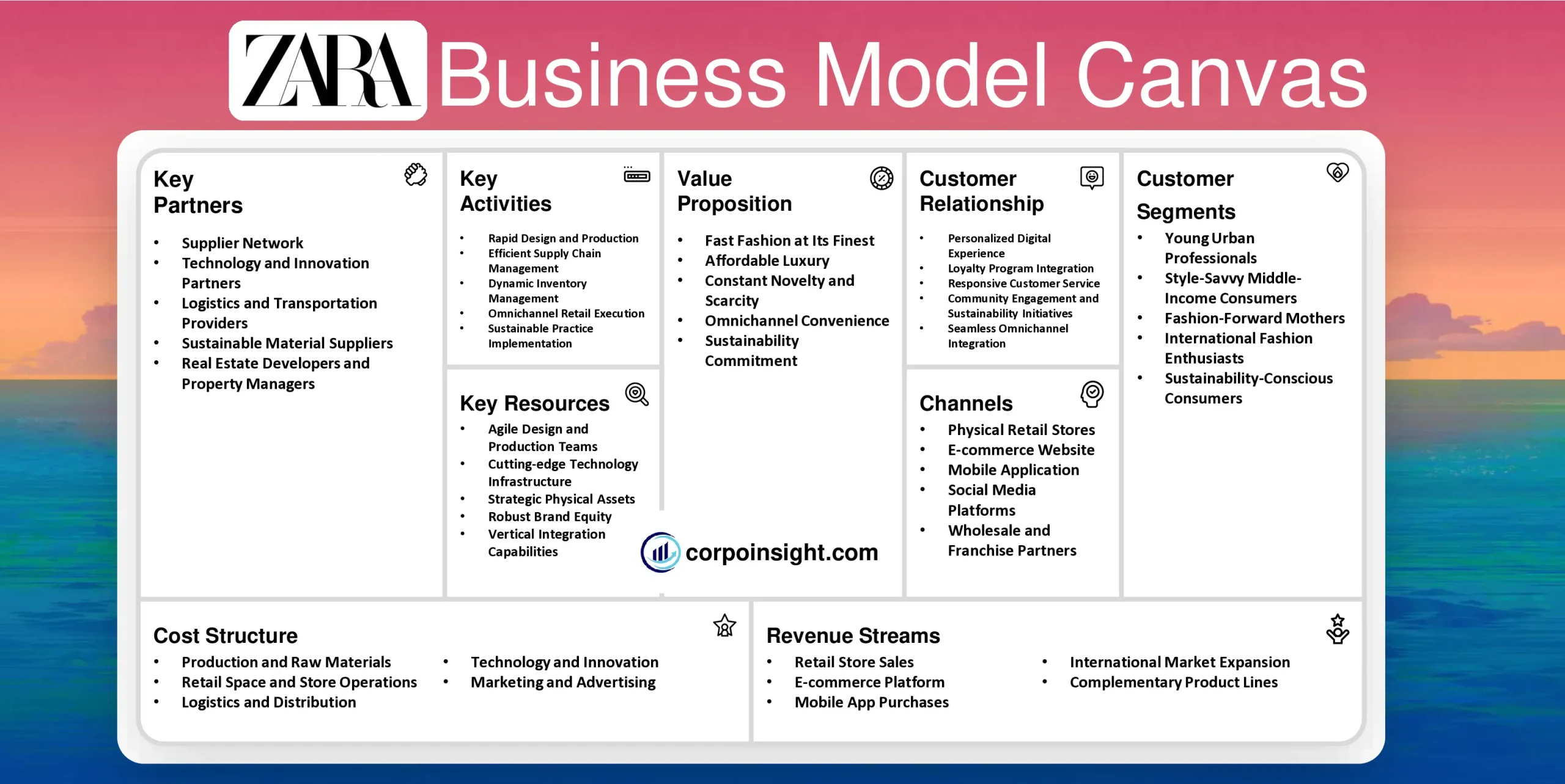Zara Business Model Canvas 2024
Zara, the fast-fashion retail giant founded in Spain, has revolutionized the clothing industry with its ability to swiftly transform catwalk trends into affordable, ready-to-wear styles, while simultaneously expanding its global footprint to become one of the world’s largest fashion retailers. In this Zara Business Model Canvas, I will identify its customer segments, value proposition, revenue streams, channels, customer relationships, key activities, key resources, key partners, and cost structure.
Interesting fact!
In-house design team: The company employs over 200 designers who create about 65,000 new items annually, of which only 50% make it to stores.
Zara Competitors
H&M | Uniqlo | Gap | Topshop | Forever 21 | Mango | Primark | Asos | Bershka | Pull&Bear
Customer Segments – Zara Business Model Canvas

Young Urban Professionals: Zara primarily targets fashion-conscious individuals aged 18-40, particularly those residing in metropolitan areas, who seek trendy yet affordable clothing for work and social occasions. This demographic, often referred to as “millennials” and “Gen Z,” values fast fashion that allows them to frequently update their wardrobe without breaking the bank.
Style-Savvy Middle-Income Consumers: While Zara appeals to a broad range of income levels, its core customer base consists of middle-income shoppers who desire high-street fashion at accessible price points. These consumers, who are often influenced by social media trends and celebrity styles, appreciate Zara’s ability to quickly replicate runway looks for everyday wear.
Fashion-Forward Mothers: Recognizing the purchasing power of family-oriented consumers, Zara has expanded its offerings to include stylish options for mothers and children. This segment, comprising women aged 25-45 with young families, seeks versatile clothing that transitions seamlessly from work to family activities, while also shopping for trendy kids’ wear.
International Fashion Enthusiasts: With its global presence in over 90 countries, Zara caters to a diverse international customer base that shares a common interest in European fashion trends. This segment, which includes tourists and expatriates, values Zara’s consistent styling and sizing across different markets, allowing for a familiar shopping experience worldwide.
Sustainability-Conscious Consumers: In recent years, Zara has been attracting environmentally aware shoppers through its commitment to sustainability initiatives. This growing segment, particularly prominent among younger generations, appreciates Zara’s efforts in using recycled materials, implementing clothing recycling programs, and working towards more sustainable production processes.
Value Proposition – Zara Business Model Canvas

Fast Fashion at Its Finest: Zara’s core value proposition lies in its ability to rapidly deliver the latest fashion trends to consumers, with an industry-leading design-to-retail cycle of just 15 days, which enables the brand to offer up-to-date styles that rival high-end fashion houses at a fraction of the cost.
Affordable Luxury: By leveraging economies of scale and efficient supply chain management, Zara provides customers with high-quality, design-driven apparel at accessible price points, thereby democratizing fashion and allowing consumers to emulate luxury styles without the accompanying hefty price tag.
Constant Novelty and Scarcity: Zara’s strategy of limited production runs and frequent inventory turnover, with new items arriving in stores twice a week, creates a sense of urgency and exclusivity that encourages customers to visit stores regularly and make quick purchasing decisions, thus fostering a “treasure hunt” shopping experience.
Omnichannel Convenience: Through its seamlessly integrated online and offline presence, Zara offers customers the flexibility to shop across multiple channels, with features such as mobile app purchasing, in-store pickup for online orders, and augmented reality apps enhancing the overall shopping experience and catering to the modern consumer’s desire for convenience.
Sustainability Commitment: Responding to growing environmental concerns, Zara has strengthened its value proposition by implementing eco-friendly initiatives, including the use of sustainable materials, a clothing recycling program, and a pledge to achieve zero waste in its operations by 2023, thereby appealing to increasingly conscious consumers without compromising on style or affordability.
Revenue Streams – Zara Business Model Canvas

Retail Store Sales: Despite the growing e-commerce trend, brick-and-mortar stores remain Zara’s primary revenue generator, accounting for approximately 80% of total sales; these physical locations, strategically positioned in high-traffic urban areas, not only drive direct sales but also serve as showrooms and distribution centers for online orders.
E-commerce Platform: Zara’s online sales have experienced significant growth, particularly accelerated by the COVID-19 pandemic, with e-commerce revenue increasing by 77% in 2020 and now representing about 20% of total sales; this digital channel, which offers a seamless shopping experience across devices, has become increasingly crucial to Zara’s revenue strategy.
Mobile App Purchases: The Zara mobile app, which combines features such as augmented reality, in-store item locators, and exclusive collections, has become a substantial revenue stream, contributing to the brand’s digital sales growth and accounting for a significant portion of online transactions, especially among younger, tech-savvy consumers.
International Market Expansion: Zara’s aggressive global expansion strategy has led to a diversified revenue stream across over 90 countries, with international sales now constituting more than 80% of total revenue; this geographical diversification not only increases overall sales but also helps mitigate risks associated with economic fluctuations in individual markets.
Complementary Product Lines: While apparel remains the core offering, Zara has expanded its revenue streams by introducing complementary product lines such as Zara Home, cosmetics, and accessories; these additional categories, which leverage the brand’s existing customer base and distribution networks, contribute to incremental revenue growth and higher average transaction values.
Channels – Zara Business Model Canvas

Physical Retail Stores: Zara’s extensive network of over 2,000 strategically located stores in prime urban areas serves as its primary channel, offering customers a tangible brand experience and immediate product access; these stores, which are designed to reflect the brand’s aesthetic and are frequently updated, act as both sales points and marketing tools, showcasing the latest collections to passersby.
E-commerce Website: Zara’s robust e-commerce platform, available in more than 200 markets, has become an increasingly vital channel, especially following the pandemic-induced shift to online shopping; this digital storefront not only facilitates direct sales but also serves as a product catalog and brand communication tool, offering features like virtual fitting rooms and seamless integration with physical stores.
Mobile Application: The Zara app, which has seen significant user growth and now accounts for over 40% of online sales in some markets, combines shopping functionality with innovative features such as augmented reality for virtual try-ons and in-store item locators; this channel caters to the mobile-first preferences of younger consumers and enhances the omnichannel shopping experience.
Social Media Platforms: Leveraging platforms like Instagram, Facebook, and Pinterest, Zara has cultivated a strong social media presence that serves as both a marketing channel and a direct sales funnel; these platforms, where Zara showcases its latest collections and engages with over 40 million followers, drive traffic to its website and stores while also gathering valuable customer insights.
Wholesale and Franchise Partners: Although less prominent than its direct-to-consumer channels, Zara maintains strategic partnerships with select wholesale and franchise operators in certain markets, particularly where direct operation is challenging; this channel allows Zara to extend its reach and brand presence in diverse global markets while maintaining control over brand representation and customer experience.
Customer Relationships – Zara Business Model Canvas

Personalized Digital Experience: Zara leverages advanced data analytics and AI to offer personalized product recommendations and tailored content across its digital platforms, which not only enhances the shopping experience but also fosters a sense of individual attention; this personalization extends to email marketing campaigns and app notifications, ensuring that customers receive relevant information about new arrivals and promotions.
Loyalty Program Integration: While Zara has traditionally eschewed conventional loyalty programs, it has recently integrated a points-based system within its mobile app in select markets, allowing customers to accumulate points on purchases and access exclusive benefits; this subtle approach to loyalty rewards aligns with Zara’s brand ethos while encouraging repeat patronage and deepening customer engagement.
Responsive Customer Service: Zara has expanded its customer service capabilities to include multi-channel support through social media, live chat, and dedicated helplines, with a focus on quick resolution and personalized assistance; this proactive approach to customer care, which often involves direct interaction between customers and store staff for product inquiries or order issues, helps maintain positive relationships even when problems arise.
Community Engagement and Sustainability Initiatives: By actively communicating its sustainability efforts, such as the clothing recycling program and commitment to eco-friendly materials, Zara fosters a sense of shared values with its environmentally conscious customer base; this alignment of brand actions with customer values strengthens emotional connections and encourages long-term brand loyalty among increasingly sustainability-minded consumers.
Seamless Omnichannel Integration: Zara’s investment in creating a cohesive experience across online and offline channels, including features like “click and collect” and in-store returns for online purchases, reflects its commitment to customer convenience; this seamless integration, coupled with consistent brand messaging across all touchpoints, ensures that customers enjoy a unified and frictionless relationship with the brand regardless of their preferred shopping method.
Key Activities – Zara Business Model Canvas

Rapid Design and Production: At the core of Zara’s operations is its industry-leading design-to-shelf cycle, which takes a mere 15 days and involves a team of over 700 designers creating approximately 65,000 new styles annually; this agile process, supported by advanced data analytics and trend forecasting, allows Zara to respond swiftly to emerging fashion trends and consumer preferences.
Efficient Supply Chain Management: Zara’s vertically integrated supply chain, with 60% of production occurring in proximity to its distribution headquarters in Spain, enables the brand to maintain tight control over quality and lead times; this strategic approach, combined with a network of over 1,700 suppliers, allows for the flexibility to adjust production quickly based on real-time sales data and market demands.
Dynamic Inventory Management: Through a sophisticated IT infrastructure and RFID technology, Zara manages its inventory with precision, replenishing stores twice weekly and maintaining low stock levels; this just-in-time inventory system not only reduces waste and storage costs but also creates a sense of scarcity that drives customer urgency and frequent store visits.
Omnichannel Retail Execution: Zara continually refines its omnichannel strategy, seamlessly integrating online and offline experiences through initiatives such as mobile app enhancements, AR try-on features, and the conversion of physical stores into online order fulfillment centers; this approach, which saw online sales grow to 32% of total sales in 2020, ensures a consistent brand experience across all customer touchpoints.
Sustainable Practice Implementation: In response to growing environmental concerns, Zara has intensified its sustainability efforts, including the use of 100% sustainable cotton by 2025, implementation of energy-efficient stores, and expansion of its clothing recycling program to over 2,000 stores globally; these initiatives not only align with consumer values but also contribute to long-term operational efficiency and cost reduction.
Key Resources – Zara Business Model Canvas

Agile Design and Production Teams: Zara’s creative workforce, comprising over 700 designers and thousands of skilled craftspeople, forms the backbone of its fast-fashion model; this diverse team, working in tandem with advanced trend-forecasting tools, enables Zara to conceptualize, design, and produce new styles at an unprecedented pace, often bringing concepts from sketch to store within two weeks.
Cutting-edge Technology Infrastructure: The brand’s proprietary IT systems and data analytics platforms, which process over 450 million items annually, are crucial for managing its complex supply chain and inventory; this technological backbone, enhanced by RFID tagging and AI-driven demand forecasting, allows Zara to make data-driven decisions in real-time, optimizing everything from production quantities to store layouts.
Strategic Physical Assets: Zara’s network of over 2,000 prime retail locations in 96 countries, coupled with its state-of-the-art distribution centers (including the 5 million square foot facility in Spain dubbed “The Cube”), constitute vital physical resources; these assets, strategically positioned for maximum market penetration and logistical efficiency, enable Zara to maintain its rapid response to market trends and customer demands.
Robust Brand Equity: The Zara brand, valued at approximately $14.7 billion in 2021, represents a significant intangible resource that drives customer loyalty and market position; this strong brand identity, built on a reputation for trendy, affordable fashion and reinforced through consistent customer experiences across global markets, allows Zara to command premium pricing within the fast-fashion segment.
Vertical Integration Capabilities: Zara’s parent company, Inditex, maintains control over 60% of its production facilities, primarily located in Spain, Portugal, and Morocco; this vertical integration, encompassing everything from textile manufacturing to distribution, provides Zara with unparalleled flexibility and speed in responding to market demands, while also ensuring quality control throughout the production process.
Key Partners – Zara Business Model Canvas

Supplier Network: Zara collaborates with over 1,700 suppliers globally, with a significant portion concentrated in Spain, Portugal, and Morocco; this diverse network, which includes both long-term partners and specialized boutique manufacturers, allows Zara to maintain its agile production model while ensuring quality and ethical standards are met across its supply chain.
Technology and Innovation Partners: To maintain its competitive edge, Zara partners with cutting-edge technology firms for solutions such as RFID tracking, AI-driven demand forecasting, and augmented reality applications; these collaborations, which include companies like JDA Software for supply chain management and Tyco for inventory control systems, enable Zara to continually innovate its operations and customer experience.
Logistics and Transportation Providers: Zara relies on strategic partnerships with global logistics companies, including DHL and UPS, to manage its complex distribution network; these partnerships, which facilitate the twice-weekly store replenishments and rapid online order fulfillment, are crucial in maintaining Zara’s responsiveness to market demands and ensuring seamless product availability across its omnichannel platform.
Sustainable Material Suppliers: In line with its commitment to sustainability, Zara has forged partnerships with eco-friendly material suppliers and innovative textile companies; these collaborations, such as its agreement with Lenzing AG for sustainable viscose fibers and its participation in the Better Cotton Initiative, support Zara’s goal of using 100% sustainable fabrics by 2025.
Real Estate Developers and Property Managers: Zara’s expansion strategy heavily depends on partnerships with real estate firms and property managers to secure prime retail locations worldwide; these relationships, often involving long-term leases and co-investment in store designs, are essential for maintaining Zara’s physical presence in high-traffic urban areas and shopping centers, which remain crucial to its business model despite the growth of e-commerce.
Cost Structure – Zara Business Model Canvas

Production and Raw Materials: While Zara benefits from economies of scale, its fast-fashion model and commitment to quality necessitate significant expenditure on production and materials; the company’s strategic decision to maintain a portion of production in proximity to its Spanish headquarters, despite higher labor costs, allows for greater flexibility and speed-to-market, which ultimately justifies the increased expenses.
Retail Space and Store Operations: Zara’s extensive network of over 2,000 stores in prime locations worldwide represents a substantial fixed cost, encompassing rent, utilities, and store maintenance; however, the brand’s high sales per square foot, which averages around $11,000 annually, significantly higher than many competitors, helps offset these expenses and maintains profitability.
Logistics and Distribution: The company’s sophisticated logistics network, including its centralized distribution system and frequent store replenishments, constitutes a major operational cost; yet, this investment in rapid and efficient distribution, which enables Zara to restock stores twice weekly and fulfill online orders promptly, is crucial to its business model and customer satisfaction.
Technology and Innovation: Zara allocates considerable resources to maintaining and upgrading its technological infrastructure, including investments in AI, data analytics, and RFID systems; while these expenses are significant, they are viewed as essential for optimizing operations, reducing long-term costs, and maintaining Zara’s competitive edge in the fast-paced fashion industry.
Marketing and Advertising: Interestingly, Zara’s marketing costs are relatively low compared to industry standards, with the company famously spending only about 0.3% of its revenue on advertising; instead, Zara relies on its prime store locations, word-of-mouth, and social media presence for brand promotion, allowing it to redirect funds to other areas of the business while maintaining a strong market presence.
Summary of Zara Business Model Canvas

Conclusion on Zara Business Model Canvas
Zara’s business model canvas exemplifies a highly efficient, customer-centric approach in the fast-fashion industry. By leveraging rapid design-to-shelf cycles, strategic partnerships, and an integrated omnichannel experience, Zara has created a unique value proposition that resonates with style-conscious consumers worldwide. The company’s focus on data-driven decision-making, sustainable practices, and technological innovation enables it to maintain its competitive edge while adapting to changing market dynamics. This agile and responsive model has positioned Zara as a leader in the global fashion retail landscape, consistently delivering trendy, affordable clothing to its diverse customer segments.

I’m Samin Yasar, currently working as a Brand Strategist for one of the world’s leading Prop Firms. I have a passion for content creation and dream of making my own film one day.







